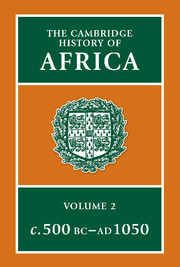Book contents
- Frontmatter
- Introduction
- 1 The legacy of prehistory: an essay on the background to the individuality of African cultures
- 2 North Africa in the period of Phoenician and Greek colonization, c. 800 to 323 BC
- 3 North Africa in the Hellenistic and Roman periods, 323 BC to AD 305
- 4 The Nilotic Sudan and Ethiopia, c. 660 bc to c.ad 600
- 5 Trans-Saharan contacts and the Iron Age in West Africa
- 6 The emergence of Bantu Africa
- 7 The Christian period in Mediterranean Africa, c.ad 200 to 700
- 8 The Arab conquest and the rise of Islam in North Africa
- 9 Christian Nubia
- 10 The Fatimid revolution (861–973) and its aftermath in North Africa
- 11 The Sahara and the Sudan from the Arab conquest of the Maghrib to the rise of the Almoravids
- Bibliographical essays
- Bibliography
- Index
- Plate Sections
- Plate Sections
- Plate Sections
- References
10 - The Fatimid revolution (861–973) and its aftermath in North Africa
Published online by Cambridge University Press: 28 March 2008
- Frontmatter
- Introduction
- 1 The legacy of prehistory: an essay on the background to the individuality of African cultures
- 2 North Africa in the period of Phoenician and Greek colonization, c. 800 to 323 BC
- 3 North Africa in the Hellenistic and Roman periods, 323 BC to AD 305
- 4 The Nilotic Sudan and Ethiopia, c. 660 bc to c.ad 600
- 5 Trans-Saharan contacts and the Iron Age in West Africa
- 6 The emergence of Bantu Africa
- 7 The Christian period in Mediterranean Africa, c.ad 200 to 700
- 8 The Arab conquest and the rise of Islam in North Africa
- 9 Christian Nubia
- 10 The Fatimid revolution (861–973) and its aftermath in North Africa
- 11 The Sahara and the Sudan from the Arab conquest of the Maghrib to the rise of the Almoravids
- Bibliographical essays
- Bibliography
- Index
- Plate Sections
- Plate Sections
- Plate Sections
- References
Summary
THE END OF THE NINTH CENTURY AD
In AD 861 the ‘Abbasid Caliph Mutawakkil was murdered by the Turkish guard in the imperial capital of Samarra on the Tigris at the instigation of the heir to the throne, his son Muntasir. As heir to the throne, Muntasir had held the province of Egypt under the system in force since the accession of Mu‘tasim in 834. Under this system, the wālī or governor had been appointed not by the caliph, but by some high officer or prince at court to whom the province was assigned. In 836 Muntasir had appointed one Yazīd b. ‘Abd Allah from the Turks who were the corps d'élite of the army in Iraq, the first Turk to hold the position in Egypt Yazīd remained in office for about ten years, but his power was limited by the separation of Alexandria and Barce (Barca) in Cyrenaica from the government at the Egyptian capital of Fustāt as well as by the independent appointment of the ‘āmi, the financial superintendent, who was responsible for the collection of revenue and the remittance of an annual māl, literally ‘wealth’, to the treasury at Samarra. Thus divided, the government of Egypt was comparatively weak, and the far south had been abandoned to Arab tribes around Aswan. Revenue accruing to the state seems also to have fallen. Much of the land was in the possession of men like Muntasir, aristocrats who may not even have lived in the country.
- Type
- Chapter
- Information
- The Cambridge History of Africa , pp. 589 - 636Publisher: Cambridge University PressPrint publication year: 1979



